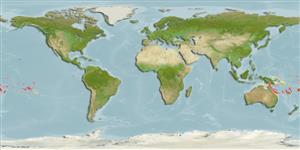>
Blenniiformes (Blennies) >
Tripterygiidae (Triplefin blennies) > Tripterygiinae
Etymology: Enneapterygius: Greek, ennea = nine times + Greek, pterygion = little fin (Ref. 45335).
More on author: Fricke.
Environment: milieu / climate zone / distribuzione batimetrica / distribution range
Ecologia
marino associati a barriera corallina; distribuzione batimetrica 0 - 17 m (Ref. 13227). Tropical
Southwest Pacific: Australia, Vanuatu, Fiji, then east to American Samoa, and the French Polynesia.
Size / Peso / Age
Maturità: Lm ? range ? - ? cm
Max length : 4.5 cm SL maschio/sesso non determinato; (Ref. 54980)
Short description
Chiavi di identificazione | Morfologia | Morfometria
Spine dorsali (totale) : 14 - 17; Raggi dorsali molli (totale) : 7 - 11; Spine anali: 1; Raggi anali molli: 17 - 21. Small and slender supraorbital tentacle; in males, first spine of first dorsal fin higher than first spine of second dorsal fin; in females, first dorsal fin a little less than 50% shorter than second dorsal fin; females whitish, with fine black dots, bearing a reticular red or brown pattern, isolating the white into 2-3 longitudinal rows of blotches; male coloration similar but generally darker. Dorsal rays III + XI-XIII + 7-10; lateral line interrupted, 14-20 + 14-21; mandibular pores 3-4 + 1 + 3-4 (Ref. 54980).
Body shape (shape guide): elongated.
Female members of the Tripterygiidae have eggs that are hemispherical and covered with numerous sticky threads that anchor them in the algae on the nesting sites (Ref. 240). Larvae are planktonic which occur primarily in shallow, nearshore waters (Ref. 94114).
Life cycle and mating behavior
Maturità | Riproduzione | Deposizione | Uova | Fecundity | Larve
Fricke, R., 1994. Tripterygiid fishes of Australia, New Zealand and the southwest Pacific Ocean (Teleostei). Theses Zool. 24:1-585. (Ref. 13227)
IUCN Red List Status (Ref. 130435: Version 2025-1)
Threat to humans
Harmless
Human uses
Pesca: di nessun interesse
Strumenti
Special reports
Download XML
Fonti Internet
Estimates based on models
Preferred temperature (Fonte Biblio.
123201): 25 - 29, mean 27.1 °C (based on 457 cells).
Phylogenetic diversity index (Fonte Biblio.
82804): PD
50 = 0.5000 [Uniqueness, from 0.5 = low to 2.0 = high].
Bayesian length-weight: a=0.00617 (0.00288 - 0.01322), b=3.04 (2.86 - 3.22), in cm total length, based on LWR estimates for this (Sub)family-body shape (Ref.
93245).
Trophic level (Fonte Biblio.
69278): 3.2 ±0.3 se; based on size and trophs of closest relatives
Resilienza (Fonte Biblio.
120179): Alto, tempo minimo di raddoppiamento della popolazione meno di 15 mesi (Preliminary K or Fecundity.).
Fishing Vulnerability (Ref.
59153): Low vulnerability (10 of 100).
🛈
Nutrients (Ref.
124155): Calcium = 371 [165, 1,059] mg/100g; Iron = 1.83 [0.77, 3.67] mg/100g; Protein = 18.3 [16.8, 19.8] %; Omega3 = 0.102 [0.036, 0.307] g/100g; Selenium = 47 [13, 150] μg/100g; VitaminA = 56 [11, 275] μg/100g; Zinc = 4.02 [2.07, 6.83] mg/100g (wet weight);
